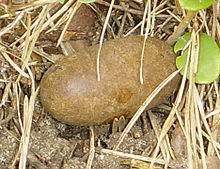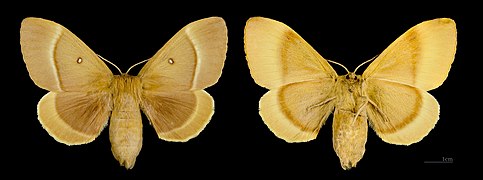Oak moth
| Oak moth | ||||||||||||
|---|---|---|---|---|---|---|---|---|---|---|---|---|

Female oak moth ( Lasiocampa quercus ) |
||||||||||||
| Systematics | ||||||||||||
|
||||||||||||
| Scientific name | ||||||||||||
| Lasiocampa quercus | ||||||||||||
| ( Linnaeus , 1758) |
The oak moth or quince bird ( Lasiocampa quercus ) is a butterfly from the cluck family (Lasiocampidae).
features
The moths reach a wingspan of 45 to 75 millimeters. Both sexes, which are clearly different from each other ( sexual dimorphism ), have very variable colored wings. The forewings of the males usually have a maroon basic color and have a broad, slightly curved band between the two rear thirds of the wing, not sharply delimited towards the wing tip. In addition, a white, dark-edged discoidal spot is conspicuous. The hind wings are colored the same, but have no discoid spots. The females are clearly lighter in color and also considerably larger than the males. They have ocher yellow or light brown wings on which the yellow band is only indistinctly visible. They also have white, dark-edged discoid spots on the forewings.
The caterpillars are about 80 millimeters long, are densely hairy and have stinging hairs that contain a nettle poison . They have a black basic color, with the back of young caterpillars bearing a yellow diamond on each segment, which has a white spot in the middle, running backwards. Older animals are brownish-gray in color and have a diamond pattern on the sides. These diamonds are light on one side and brown on the other, similar to the basic color. The caterpillars also have thick, gray-brown hair pads on their backs. Between the segments there are bare stripes that are black in color.
Similar species
- Moth clover ( Lasiocampa trifolii )
Occurrence
The animals are found all over Europe , except in the far north and parts of the Mediterranean region , east to the Altai . They live in loose forests , moor areas and are particularly common in the Alps near the tree line . Their occurrence has declined sharply in many places.
Way of life
The males fly around wildly during the day in search of females. These, in turn, are usually nocturnal, only in higher altitudes they also fly during the day.
Flight and caterpillar times
The moths fly from late June to mid-August, the caterpillars are found from September to May of the following year.
Food of the caterpillars
The caterpillars feed on various bushes, including blackthorn ( Prunus spinosa ), blackberries ( Rubus fruticosus ), broom ( Cytisus scoparius ), blueberry ( Vaccinium myrtillus ), bogberry ( Vaccinium uliginosum ), willow ( Salix spec. ) And broomstick ( Calluna vulgaris ). They very rarely feed on oak trees , although their name suggests this.
development
The females drop the relatively large, light brown eggs on the vegetation in flight . The caterpillars overwinter and pupate in the following year from the end of May to the beginning of June on the ground or between coiled leaves (e.g. blackberry leaves) in a parchment-like, solid, oval cocoon . The cocoon has a length of about 30 mm. In one case, pupation lasted from mid-June to mid-July, a total of 34 days.
Hazard and protection
- Red list FRG: V (on the pre-warning list).
swell
Individual evidence
- ↑ a b c d e f g Heiko Bellmann : The new Kosmos butterfly guide. Butterflies, caterpillars and forage plants. Franckh-Kosmos, Stuttgart 2003, ISBN 3-440-09330-1 , p. 78.
- ↑ Hans-Josef Weidemann, Jochen Köhler: Moths. Weirdos and hawkers. Naturbuch-Verlag, Augsburg 1996, ISBN 3-89440-128-1 , pp. 98ff.
- ↑ Lasiocampa quercus. Butterflies-Deutschlands.de, Christian Tolasch, accessed on November 7, 2006 .
literature
- Günter Ebert: The butterflies of Baden-Württemberg Volume 4, Nachtfalter II. Ulmer Verlag Stuttgart 1994. ISBN 3-800-13474-8
Web links
- www.lepiforum.de Taxonomy and photos
- European butterflies
- www.schmetterling-raupe.de
- Moths and Butterflies of Europe and North Africa (English)
- Guide to the Moths of Great Britain and Ireland (English)
- Lasiocampa quercus at Fauna Europaea





